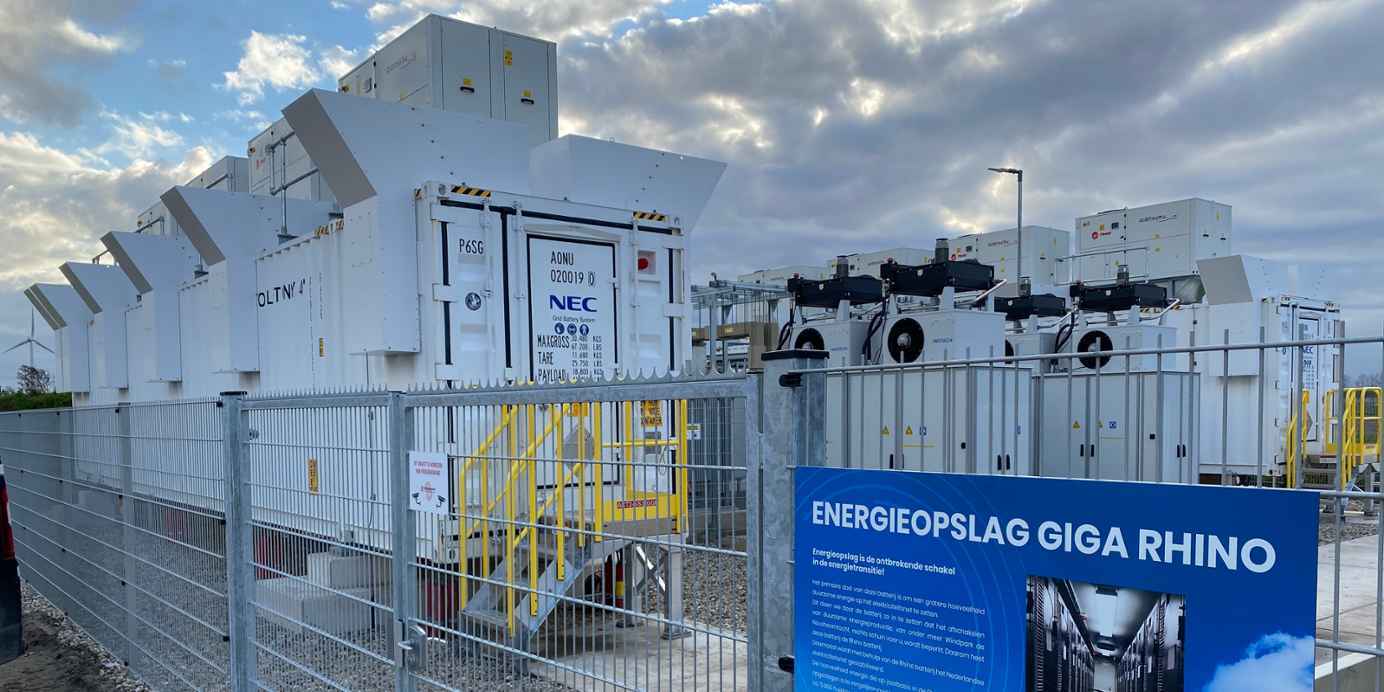The transition to reliable new forms of energy entails more than building generation capacity. The influx of windmills and solar panels has created an imbalance in the supply and demand of energy. Innovative thinking, but also legislation, regarding the challenges related to efficiency, storage, and variability are required to level-out these imbalances.
The needed component to the renewable energy transition
Luckily there are innovators and entrepreneurs accelerating the change. On 26 November 2020, the most powerful energy storage facility in the Netherlands began operation. Giga Rhino is a utility scale Lithium-ion energy storage system of 12 MW/7.5 MWh. On an annual basis, the Giga Rhino super battery stores enough power to reduce CO2 emissions by 12.5 million Kg and the electricity stored in the system on a yearly basis can be compared to the electricity consumption of around 5,000 households in the Netherlands.
Triodos Energy Transition Europe Fund (formerly Triodos Renewables Europe Fund) provided a EUR 1.2 million subordinated loan to Giga Rhino in May of 2020.
We sat down with the CFO of Giga Storage, Lars Rupert and Investment Manager Bastiaan Gielink to discuss some of the challenges faced in the energy transition and the importance of investment in energy storage.
Can you explain the importance of storage in the energy transition?
Lars: “The proportion of renewable production is increasing in large numbers and this is primarily caused by a new mix of solar and wind production. But we’re at a point where the increase of renewable energy production alone is not providing a reliable enough substitution for the coal or gas-fired plants. Without energy storage, we overproduce at one moment or run into a deficit at another. Unfortunately, it’s impossible to align this variable production with our consumption. We can’t all vacuum our houses or charge our vehicles at the same time when there is sufficient production, and we can’t control the weather. Energy storage allows for that flexibility in the demand and production of energy. If we are dedicated to this transition and to meeting the Paris Climate Agreement goals of CO2 reduction, then energy storage is what is needed right now.”
Which role does Giga aim to play in the energy transition?
Lars: “We see ourselves as asset developer, asset owner and asset manager of energy storage solutions and aim to become a market leader in Europe. We hope to expand to other countries and are looking at Germany and Belgium as we speak, working with market parties and service providers to provide energy storage solutions for them.”

Giga Rhino storage battery

Inside the battery
What are the main obstacles we currently face in financing the energy transition?
Bastiaan: “As an investor, the return that you expect to generate on your investment is to a certain extent the compensation for taking a corresponding level of risk. While the risk appetite of investors varies, there are limits to the level of uncertainty to which professional investors like to be exposed. In order to facilitate investment in transition technologies such as energy storage, the government can play an important role by providing incentive programs or support schemes. If the government has a strong and clear vision on the energy transition and provides a clear roadmap of incentive schemes, the opportunity to scale up increases. Unexpectedly changing incentive schemes every couple of years increase uncertainty. Entrepreneurs and investors build a business case around these incentive schemes and if they were to alternate due to a lack of vision, then the business case falls through and it makes it very difficult to scale up investments in new energy transition technologies such as storage.
Lars: At the same time, it’s also an obligation for entrepreneurs to have conversations with investors, understanding their needs and improving the business case for them, like what we had with Triodos Energy Transition Europe Fund. It remains difficult for battery storage projects to make a solid profitable case due to the reasons we’ve listed. Business cases can be further strengthened by discussing together all the needs and opportunities to reduce risk and increase returns. As a testament to collaboration, Triodos Energy Transition Europe Fund not only closed our investment gap with its EUR 1.2 million loan for Giga Rhino, but the fund will also enter a partnership with Giga storage in the next projects. It’s a win-win.”
How does Triodos Energy Transition Europe Fund seek to push the transition further?
Bastiaan: “Renewable generation and financing these generation technologies have become more mainstream, which is great. Our fund will, of course, continue to finance such projects. Yet there’s a lot more work to be done in the energy transition apart from generation, for example in energy storage, but also in improving energy efficiency. From our perspective, we are always looking for new ways to push the energy transition. There’s currently only a limited amount of parties in the market providing equity or mezzanine finance for energy storage. As an investor, if we step into a new technology like this, we need to have a lot of trust in management and that trust comes from collaboration, market acuity and the ability to deliver on promises, like what we’ve experienced with Giga Storage. Further, we also want to challenge the innovation. If we are going to reduce CO2 emissions, we must look at the transition through a holistic lens, and as an investor, that’s what we’re currently doing.
Explore our Energy and Climate impact report ‘Accelerating the energy transition’ to find out more about our role as impact investor. The report presents our 2020 results in a context of numbers and stories and showcases our mission to make money work for positive change.

